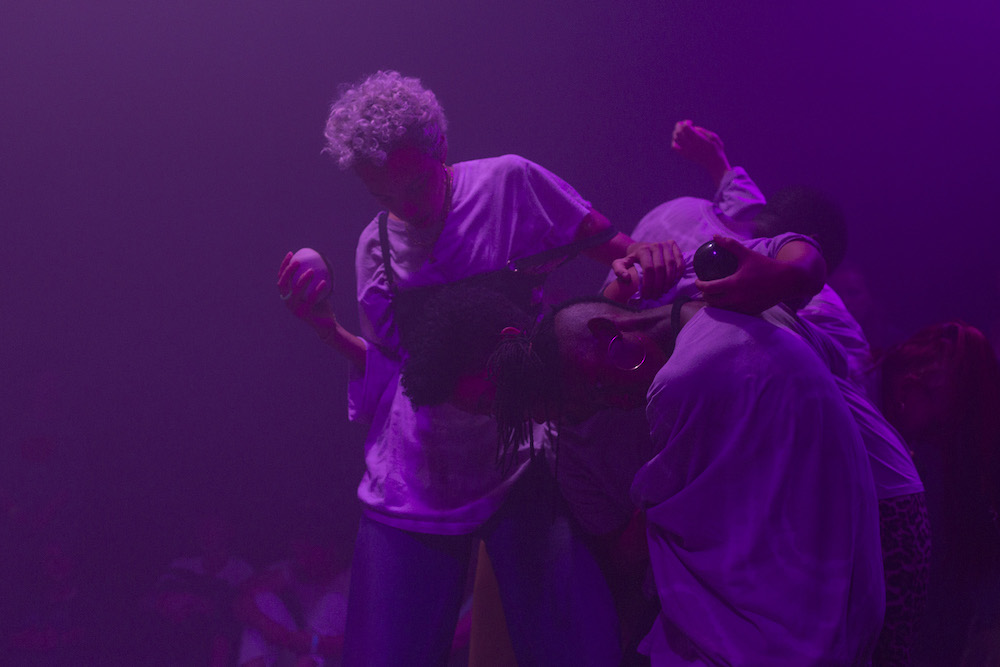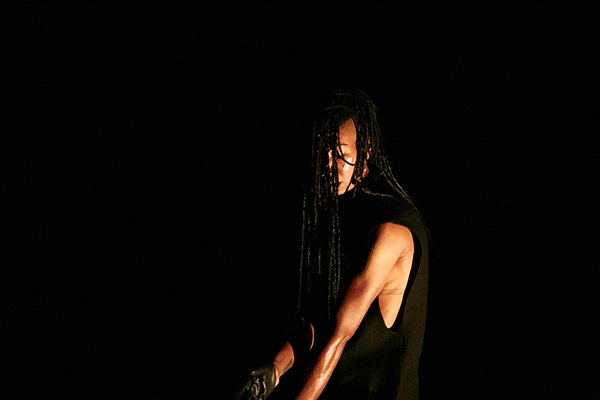“Oh, okay, maybe there is something I have to bring here,” says Jamila Johnson-Small about a moment of realisation during her time at Lewisham College. “The director of the college at the time called me into her office and asked me why I wasn’t planning on auditioning for dance school and told me that I should. So I did…”.

Otherwise known as Last Yearz Interesting Negro, the London-based artist and performer has been working both solo and with the likes of Alexandrina Hemsley as Project O and long-time friend Phoebe Collings-James. The latter collaboration includes the recent ‘Sound as Weapon, Sounds 4 Survival‘ performance at Wysing Arts Centre in September, where the duo physically charted “psycho-emotional landscapes” using multi-dimensional bodies as technology across dance, music and sculpture, along with Yasmine Akim, Onyeka Igwe and Katarzyna Perlak.
“I was so moved by music and found it so interesting that we (culturally) engage so casually with this art form and not, say, with dance ,” Johnson-Small adds about the way it “literally penetrates our bodies and we welcome it.” Having been drawn to punk and grunge early on, it’s electronic production that now takes pride of place in the choice of musical styles in Last Yearz Interesting Negro works. “It’s a different context now and contemporary music is electronic music,” she says about the shift to collaborating with sound artists, musicians, DJs and sound designers in 2014, as an attempt to gain more control over the music and its references. “I was having a conversation the other day with Phoebe about how it was to first be hearing grime and the shock of the way in which those sounds were the sounds of the city to us. I am interested in that.”
**It feels like words are an important part of your work, and I often think about the language as a construction that determines our reality. Given that you write yourself and initially set out to study English and Italian: firstly, that’s an interesting pairing, but secondly, is dance perhaps an attempt at transcending the limits of the spoken word?
Jamila Johnson-Small: Everything has limits and I am interested in how those ‘limitations’ might speak; how they might be our own perceptions; how from different angles, in different proximity and in different relations, things can look different. I work with composition and poetry, I think the way that words and bodies hold shifting meaning and histories is not so dissimilar. Or maybe I have given up on the idea of transcendence as a useful strategy for navigating the present.

**Of course, much of your work, or at least the discourse around it, is concerned with the oppressive conventions of dance as an established art form in certain contexts. You mentioned in an interview that dance appears to be suppressed within white supremacy, except in proscribed spaces, like ballet etcetera, what are your thoughts on this contradictory space that dance inhabits — as both an emancipatory practice and oppressive system?
JJS: Dance is fascinating to me, in part because it is just something that people do. I mean, the whole patriarchal project of the mind-body split, cogito, ergo sum bullshit is tedious. I think dance is much more than emancipatory or oppressive. But if we are talking about the history of (western concert) dance that is taught in educations, like the one I participated in (from GCSE to Masters), and the practices that were taught to me in a dance conservatoire, and the work that gets the mega funding in the UK, then what I’d say is that dance itself isn’t the oppressive system but what is often being pushed can carry forward oppressive ideologies.
**How do you think this applies to inhabiting institutional spaces as an artist?
JJS: The question of the emancipatory and the oppressive? Isn’t everything navigating those tensions in a way? I mean, emancipation is a myth in the total sense of the word and everything comes at a cost. It’s a balancing act.

**You’ve mentioned before a discomfort with black and queer representation in contemporary art and media. Visibility is obviously a complicated notion as a representational force, do you feel any closer to disentangling the consequences (responsibility, even) of becoming more visible in these institutional spaces?
JJS: Not. At. All. I don’t know if I am even trying, or should I say able to try, to do any disentangling right now. I mean, I am having a lot of difficult conversations and maybe some people don’t like or want to work with me because of that. Beyond any identity ‘issues’, I have work to make and bills to pay and trainers to buy. I am very aware of the tokenistic gestures that are many of the invitations that I get to share work but, at the same time, I have to trust that the work is more than that, can destabilise that. More than trust, I have to work for the work to destabilise those things, always, because I need the space to exist and grow. To myself, I am the norm so I can’t approach myself as ‘other’.
It’s worth saying, too, that the landscape has changed (on the surface) so much these last few years and switches up the conversations around visibility and representation slightly.
**You often collaborate with others in your work but it feels like (correct me if I’m wrong) the pieces themselves are quite internal. Is there a broader purpose behind sharing the experience out amongst your other collaborators?

JJS: This question makes me a little uncomfortable… I know you’ve seen ‘Sounds 4 Survival’ that had a cast of five but most often I perform alone, or as duo in Project O. Often I collaborate with people working in different media — sound, sculpture, light… I don’t think I am making work that is any more personal than the next person. I think all of our gestures are expressive and reveal us. I collaborate because I want to expand my thinking and my doing; to become wider and sharper and softer and I guess to temper certain tendencies within myself. It is good for me to work with other people, navigating spaces, ideas, intimacies. You know, to stay grounded enough to fly. Also to share and encounter myself, to get some perspective, to learn about navigating tensions. But also because I love to see other people having space to do what they do and if I can support that, encourage that and get to be around that, then life is good, you know. It’s very nourishing.
I have always been interested in the idea of having different desires and agendas articulated within the same space, whether this is possible, like how to be together in general as humans. For me, it’s super important to try to understand how to meet and how to be met.
I think a lot of what I do is read as personal because of the ‘identity’ situation — my blackness, perceived queerness and I guess my working with improvised non-codified dancing. A lot of the practices I am working with are not about me. I don’t make things for myself personally, I make them for ‘myself’ politically. I am interested in the gaps. When there are enough other people doing what I do, I will stop because I wont need to do it.
My practice, I think, can be invisible in ways. A lot of the early work I was making people would liken to bedroom dancing. I want to facilitate spaces where people can do what they do, watch and be with them going deep and I try not to have any agenda around what that should look like in itself. But then I like to organise things, things in space, over time, atmospheres and rhythms, to be in charge of the framing and composition. It’s like writing poetry — how do you work with the words and the gaps between the words, the multiplicity of meanings, the flows, the punctuation… I love it.**













